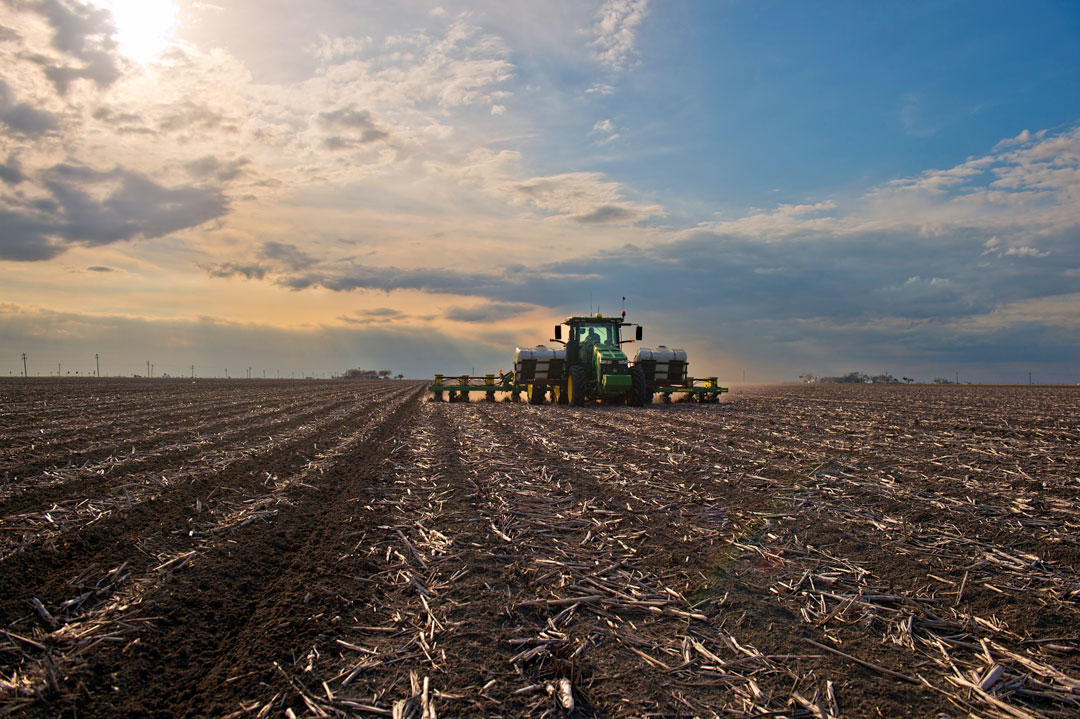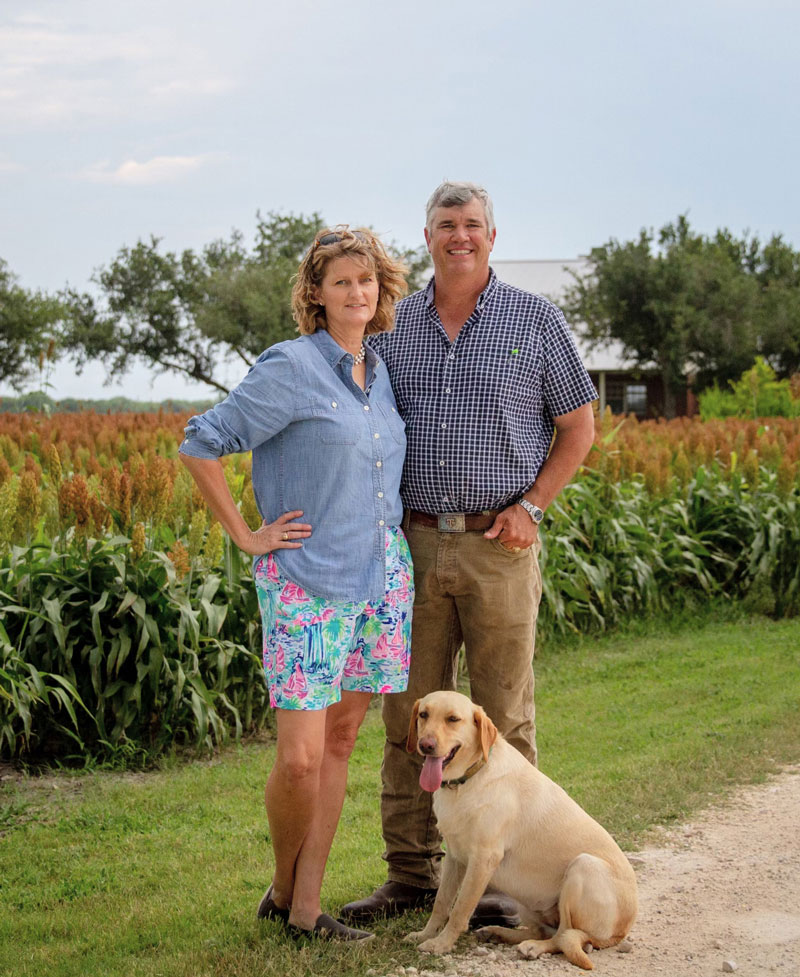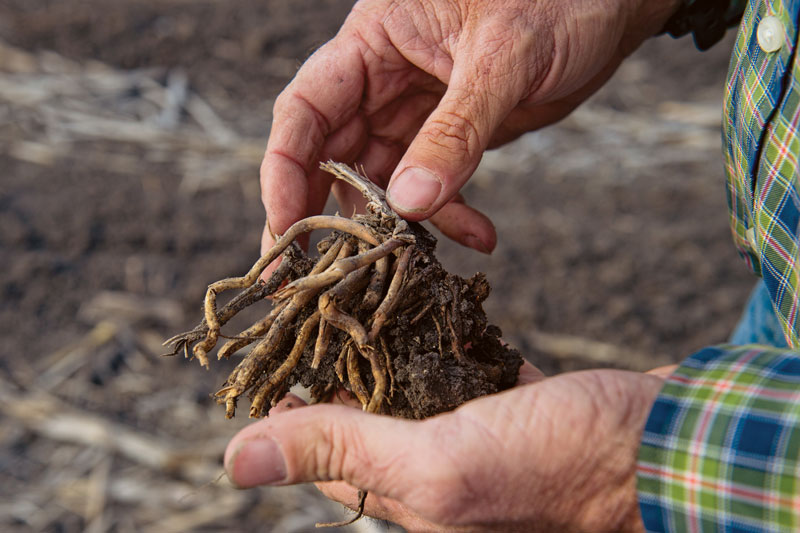
Photo by Eddie Seal
Jon Whatley plants cotton between strips of stubble left from last year’s milo crop. Strip-tillage helps to build organic matter, retain moisture and prevent soil erosion, a common problem near the windy Texas Gulf Coast.
South Texas farmer Jon Whatley won’t ever forget Easter Sunday, 2005. While his family attended church, he drove a tractor in a last-ditch effort to save their crops from a sandstorm.
“My father and I ran sand-fighter plows all day,” Jon recalls, referring to an implement that roughens up the soil, so it doesn’t blow away. “But we were only able to save two-thirds of our crops. I remember thinking ‘There’s got to be a smarter way to stop the sand from sawing off our seedlings.’ That’s when I realized I needed to partner with Mother Nature — not work against her.”

Photo courtesy of Whatley family
Kelly and Jon Whatley make it a priority to be good environmental stewards of their fourth-generation family farm near Odem, just 10 miles from the Texas Gulf Coast.
Farming near the Coast
Like three generations before him, Jon farms near Odem, just a few miles from the Texas Gulf Coast. With his wife, Kelly, and their sons, Payne and Jackson, he operates J&K Whatley Farms. Together, the Texas Farm Credit customers produce cattle, cotton, corn and grain sorghum.
After their losses in 2005, Jon knew traditional dryland farming practices wouldn’t work anymore. Instead, conservation-focused methods were the way to go.
Reducing tillage
“Healthy soil became my No. 1 goal,” he explains. “I had to reduce tilling in order to leave behind more organic matter, which retains moisture and prevents erosion from water and wind.”
No-till was not an option for the Whatleys, so they switched to a hybrid of no-till and conventional till known as conservation strip-till. With this method, they till the strips of soil where seed will be planted. Between the strips, they leave the ground in its natural state to allow organic matter to build.
The Whatleys have adopted other sustainable soil and water conservation measures too – many administered by the San Patricio Soil and Water Conservation District and the USDA’s Natural Resources Conservation Service.
Techniques include crop rotation, terraces, grassed waterways, surface roughening and controlled traffic farming, which minimizes soil compaction.
“We implement conservation programs as directed by government guidelines,” Jon says. “Then over time, we modify them to make them work for our operation and our goals.”
The benefits, such as better nutrient and water retention, don’t happen right away. It’s often three or four years before they see results.

Photo by Eddie Seal
Stubble from last year’s crop will decompose and contribute nutrients to the soil.
Building organic matter
“Organic matter retains moisture, so it’s not lost to evaporation and erosion. As it decays, the matter releases nutrients that are available for the next plants,” Jon says. “When I used to plow and disk, I was trying to get rid of organic matter because I thought it created issues. Now I want as much organic matter as I can get in the soil.”
Conservation also plays an important role in the Whatleys’ cow-calf operation. They control brush, cross-fence pastures and manage grazing to prevent runoff.
“One way we manage grazing is through water traps,” says Jon. “Think of a bicycle spoke with water in the middle. We rotate grazing around, and cows always go to the water trap. We move grazing to each spoke to keep grass fresh and growing. We never overgraze spokes.”
“I had to reduce tilling in order to leave behind more organic matter, which retains moisture and prevents erosion from water and wind.”
– Jon Whatley
Earning 2020 Conservation Farmer title
For their efforts, J&K Whatley Farms was awarded the 2020 Conservation Farmer title from the Texas State Soil and Water Conservation Board and the Association of Texas Soil and Water Conservation.
Texas Farm Credit believes it’s an honor the Whatleys richly deserve.
“The Whatleys have a passion for farming and strive to be good stewards of the land,” says Texas Farm Credit Branch Manager Jason Floyd. “They stay educated and surround themselves with knowledgeable people.”
Jon and Kelly have financed farmland and operating expenses with Texas Farm Credit’s Robstown branch since 2013.
“We couldn’t do what we do without Texas Farm Credit,” says Kelly. “When we’ve needed to buy different equipment, such as a vertical tillage tool, they’ve been supportive.”
Making good business sense
Looking toward the future, the Whatleys believe farming with conservation in mind makes both good business and long-term sense.
“Yes, we want healthy soil and clean water and air right now and also for the next generation,” Kelly says. “But there’s a financial component, too. We’re saving money and fuel when we spend less time tilling on a tractor, which means less wear and tear on our equipment.”
Kelly also appreciates another bonus of conservation farming.
“When we first built our house on the farm, no wildlife existed,” she says. “Since we’ve shifted to our conservation practices, we see squirrels, skunks, rabbits, coyotes and all kinds of birds!”
— Sheryl Smith-Rodgers